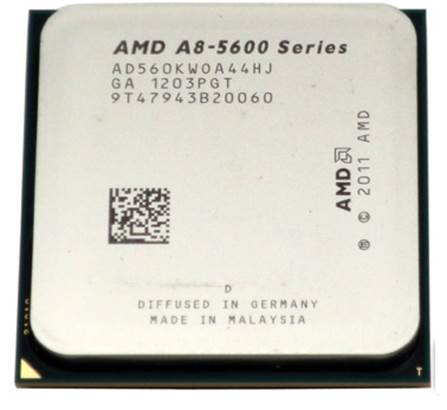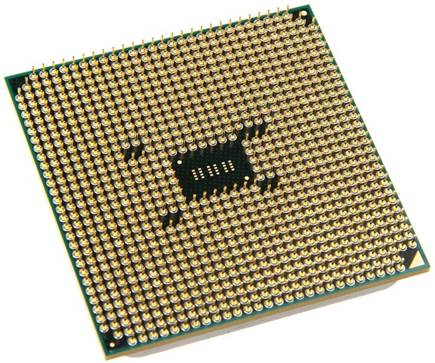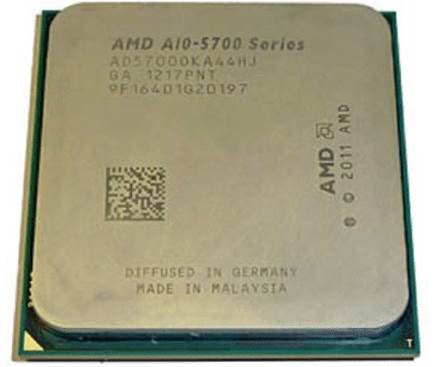We’ve rounded up six of the best
budget CPUs to find out which deserves a place in your PC.
AMD A8-5600K
Decent overclocking and GPU, but the
A10-5800K makes more sense
Piledriver
Decent stock performance; easily overclocks
above A10-5800K frequencies; fair on board GPU
Piles
100W TDP; A10-5800K’s GPU superior; Intel
CPUs better for discrete GPUs
How much?
Price: $111
Manufacturer: www.amd.com

The A8-5600K has the same pair of
Piledriver cores as the A10-5700 and A10-5800K, but clocked at a lower stock
frequency of 3.6 GHz, with a Turbo Core speed of up to 3.9 GHz. Its 100WTDP
means it has more headroom for Turbo Core to boost to its higher frequency,
though, and its unlocked multiplier allows overclocking too.
The A8-5600K also carries a scaled down on
board GPU compared to the 5800K, with the SIMD count declining to four units of
64 stream processors, for a total of 256. It also drops eight texture units,
for a total of only 16, although it still sports ROPs. As with the A10-5800K,
the A8-5600K supports memory up to 2,133 MHz (1,866MHz officially), which is
shared with the on-board GPU. At its stock speeds, the A8-5600K’s HD 7560D GPU
is clocked at 760 MHz, but as with the multiplier, this is unlocked to allow
overclocking.
While faster than the A10-5700, the
A8-5600K is generally slower than the Pentium G2 120 in 2D. The A8-5600K scored
959 in our image editing test compared to the Pentium’s 1,510.A video editing
score of 1871 for the A8-5600K surpassed the Pentium chip by over 200 points,
though, before a multi-tasking score of 1,121 again saw the AMD chip lose out,
with an overall score of 1,317 points compared to the Pentium G2 120’s 1,499.
The Intel chip was also better in discrete GPU performance, with a minimum
frame rate of 49fps in Crysis 2, compared to the A8-5600K’s 45 fps.
However, the A8-5600K thrashed all the
Intel chips in on-board GPU. A minimum frame rate of 21fps in Skyrim is more
than double that of the Intel Core i3-3225’s Intel HD 4000 graphics, but still
close to 20 per cent slower than the A10-5800K-you’ll need to drop the settings
if you want it to be playable.
The A8-5600K also proved an able over clocker.
With an additional 0.162V on the vcore, for a core voltage of 1.536V, we could
run the chip at a stable 4,4Hz. The GPU also proved pliable, and reached 1GHz
without issue. This boosted the A8-5600K’s overall score in our media
benchmarks to 1,454 – only 25 points shy of the overclocked A10-5800K.
Meanwhile, the minimum frame rate in Skyrim rose to a near-playable 24fps.
Meanwhile, the peak total system power
consumption of 153W was the highest on test, but still nothing to worry about.

Conclusion
Despite being a capable all- rounder for
$111, we’re unable to recommend the A8-5600K. If you want an all-in-one chip,
the 5800K’s superior GPU makes it worth the extra $23, while the Intel Core
i3-3220 is a better partner for discrete GPUs.
Scores
§
Speed: 36 / 50
§
Features: 11 / 15
§
Value: 32 / 35
AMD A10-5700
A low TDP, but also lower clock speeds and
no overclocking
Power
Low power consumption; decent on-board GPU
performance
Corruption
Slower 2D performance than A8-5600K; no
overclocking
How much?
Price: $135
Manufacturer: www.amd.com

Unlike the A10-5800K, which packs a hefty
100W TDP, the A10-5700 has a relatively meager TDP of 65W. This is still 10W
higher than the Intel chips on test, but still a healthy drop considering
there’s relatively little physical difference between the A10-5700 and the
A10-5800K.
It’s pair of dual core Piledriver units run
at 3.4 GHz, but they can also boost to up to 4GHz. However, as the chip’s TDP
is much lower, the A10-5700’s capacity to boost all four cores in CPU-intensive
circumstances is reduced. As it lacks that elusive ‘K’ moniker, you also can’t
overclock the A10-5700’s CPU or GPU.
Despite its reduced TDP, The A10-5700
carries the same capable Radeon HD 766D GPU as the A10-5800K, with its North
Islands architecture using six SIMDs of 64 stream processors, 24 texture units
and eight ROPs. The GPU runs at a slightly lower clock speed of 760 MHz,
though, and we found that, unlike the A10-5800K and A8-5600K, the chip wouldn’t
work with 2,133MHz memory, instead capping at the AMD - recommended maximum
frequency of 1,866 MHz.
Although the A10-5700 can use Turbo Core to
boost to 4GHz, it was slower than the A8-5600K in testing, a chip that only
boosts to 3.9 Hz but clearly does so on a more regular basis. The image editing
score of 919 was the lowest on test, although the video encoding score of 1,799
points is respectable, thanks to the multi – threaded nature of the Piledriver
architecture. The score tails off again in the multi-tasking test for an
overall score of 1,266-50 points behind the A8-5600K and 100 behind the
A10-5800K.
With a discrete GPU fitted, the 5700’s
minimum frame rate in Crysis 2 of 44fps was also the lowest on test [albeit
just 1fps slower than the A8-5600K]. Meanwhile, the A10-5700’s reduced GPU
clock and inability to support 2,133MHz memory saw its on board GPU’s Skyrim
performance slide a little, but its 384 stream processors still resulted in an
Intel-battering minimum frame rate of 23fps. Even Intel’s Core i3-3225 with HD
4000 graphics could only manage a minimum frame rate of 8fps at 1,920 x 1,080
with High detail, offering little competition.
The A10-5700 delivered on its low power
consumption claims too. With both Prime95 and Unigine’s Heaven 3 benchmark
looping, we observed a peak system power of 111W; 33W lower than with the
A10-5800K installed.

Conclusion
While it consumes little power, the
A10-5700’s lower TDP also sees 2D performance drop below that of a chip that’s
$23 cheaper. While its GPU remains highly competitive, the 33W saving [which is
only at peak load anyway] isn’t worth the drop in performance.
Scores
§
Speed: 36 / 50
§
Features: 13 / 15
§
Value: 26 / 35